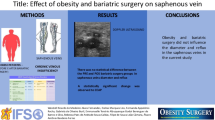Abstract
To study GSV diameter at proximal thigh and its correlation with CEAP, VCSS, and quality of life. Prospective observational study. All patients diagnosed as varicose veins in the department of general surgery at a tertiary care hospital between November 2017 and October 2018 were included in the study. Secondary varicose veins and other lymphovascular disorders were not included in the study. A total of 100 patients were included in the study after exclusion criteria. Eighty were males and 20 were females. There was non-significant positive statistical correlation between the GSV diameter at proximal thigh and C scoring of CEAP, VCSS, and quality of life (CIVIQ-14 questionnaire). GSV diameter cannot be made as a sole prediction criteria for clinical severity as other factors like early detection, compliance to treatment, presence of reflux, or not are a few of the many compounding factors.

Similar content being viewed by others
References
Mirji P, Emmi S, Joshi C (2012) Study of clinical features and management of varicose veins of lower limb. J Clin Diagn Res 5(7):1416–1420
Gibson K, Meissner M, Wright D (2012) Great saphenous vein diameter does not correlate with worsening quality of life scores in patients with great saphenous vein incompetence. J Vasc Surg 56:1634–1641
Mendoza E, Amsler F, Kalodiki E (2016) Correlation between great saphenous vein diameter next to the saphenofemoral junction and at proximal thigh with C of CEAP and venous clinical severity score (VCSS). Phlebologie 45:29–35
Irodi A, Keshava SN, Agarwal S, Korah IP, Sadhu D (2011) Ultrasound Doppler evaluation of the pattern of involvement of varicose veins in Indian patients. Indian J Surg 73(2):125–130. https://doi.org/10.1007/s12262-010-0195-0
Kaplan RM, Criqui MH, Denenberg JO, Bergan J, Fronek A (2003) Quality of life in patients with chronic venous disease: San Diego population study. J Vasc Surg 37:1047–1053
Vuylsteke ME, Colman R, Thomis S, Guillaume G, Van Quickenborne D, Staelens I (2018) An epidemiological survey of venous disease among general practitioner attendees in different geographical regions on the globe: the final results of the vein consult program. Angiology 69:779. https://doi.org/10.1177/0003319718759834
Shepherd AC, Gohel MS, Lim CS, Davies AH (2011) A study to compare disease-specific quality of life with clinical anatomical and hemodynamic assessments in patients with varicose veins. J Vasc Surg 53:374–382
Michaels J, Campbell W, Brazier J, Macintyre J, Palfreyman S, Ratcliffe J et al (2006) Randomised clinical trial, observational study and assessment of cost-effectiveness of the treatment of varicose veins (REACTIV trial). Health Technol Assess 10:1–196
Gloviczki P, Comerota AJ, Dalsing MC, Eklof BG, Gillespie DL, Gloviczki ML et al (2011) The care of patients with varicose veins and associated chronic venous diseases: Clinical practice guidelines of the Society for Vascular Surgery and the American Venous Forum. J Vasc Surg 53(5 Supplement):2S–48S
Labropoulos N, Tiongson J, Pryor L, Tassiopoulos AK, Kang SS, Ashraf Mansour M, Baker WH (2003) Definition of venous reflux in lower-extremity veins. J Vasc Surg 38:793–798
Navarro TP, Delis KT, Ribeiro AP (2002) Clinical and hemodynamic significance of the greater saphenous vein diameter in chronic venous insufficiency. Arch Surg 137:1233–1237
Musil D, Herman J, Mazuch J (2008) Width of the great saphenous vein lumen in the groin and occurrence of significant reflux in the saphenofemoral junction. Biomed Pap Med Fac Univ Palacky Olomouc Czech Repub 152:267–270
Author information
Authors and Affiliations
Corresponding author
Ethics declarations
Conflict of Interest
The authors declare that they have no conflict of interest.
Ethical Approval
Institutional ethical committee clearance was obtained at start of study. Study was conducted with ethical clearance.
Informed Consent
All patients’ data were used with informed consent.
Additional information
Publisher’s Note
Springer Nature remains neutral with regard to jurisdictional claims in published maps and institutional affiliations.
Rights and permissions
About this article
Cite this article
KK, A., Kumar, M. Can Great Saphenous Vein Diameter Be Correlated with Clinical Severity Scores and Quality of Life in Indian Population?. Indian J Surg 83, 244–247 (2021). https://doi.org/10.1007/s12262-020-02284-x
Received:
Accepted:
Published:
Issue Date:
DOI: https://doi.org/10.1007/s12262-020-02284-x




